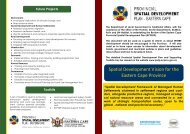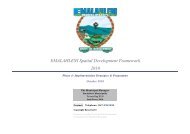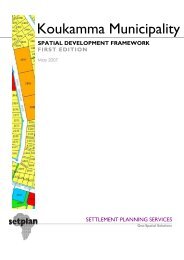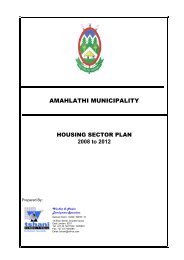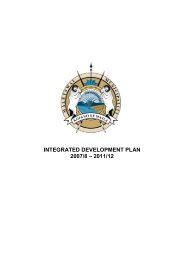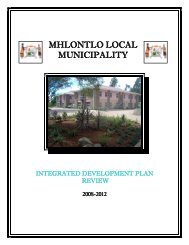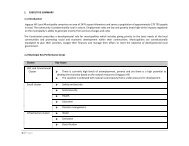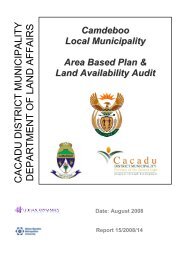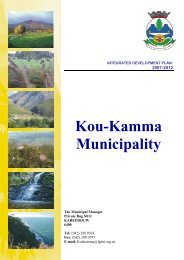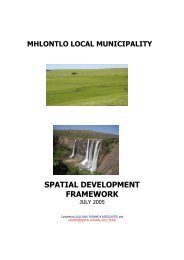intsika yethu local municipality - Provincial Spatial Development plan
intsika yethu local municipality - Provincial Spatial Development plan
intsika yethu local municipality - Provincial Spatial Development plan
Create successful ePaper yourself
Turn your PDF publications into a flip-book with our unique Google optimized e-Paper software.
(Part B) The <strong>Development</strong> Context and Socio-Economic Profile3. Socio-Economic Profile3.1 Demographic ProfileThis section provides a detailed analysis of the population of IYLM and provides some key insights intodemographics, socio-economic conditions, infrastructural service levels within the Municipal area andenvironmental issues. The analysis lends weight to prioritisation of identified issues within the IYLM andconveys some urgency with regards to what needs to be done first.The primary source of information is the Eastern Cape Social and Economic Consultative Council(ECSECC). This information was selected due to its comprehensive nature, free access and availability forpublic scrutiny. Global Insight, Census 2001 and Community Survey data is also utilised particularly whereCHDM used this information or collected new information regarding the water and sanitation backlogsthat exist in the District Municipal area.Table 14: IYLM population estimates over the previous term with forecasts for 2010/11Population distribution over the previous termPopulation estimatesArea 2006 2007 2008 2009 2010 2011Inxuba 56,354 54,562 52,750 52,079 51,782 51,236YethembaTsolwana 31,554 30,871 30,206 30,023 29,982 29,846Inkwanca 18,230 17,413 16,615 16,350 16,265 16,059Lukanji 202,209 206,154 209,803 211,921 213,234 215,084Intsika 184,308 185,211 185,843 186,044 185,934 186,031YethuEmalahleni 129,197 128,921 128,506 128,366 128,208 128,062Engcobo 147,131 144,962 142,658 141,707 141,149 140,329Sakhisizwe 60,505 59,243 58,017 57,710 57,686 57,473Chris Hani 829,646 827,491 824,545 824,346 824,383 824,263DMEastern Cape 6,627,460 6,669,749 6,703,452 6,728,955 6,743,823 6,765,781Source: ECSECC, Statistics Database, 2011.The table above shows us IYLM’s total population in relation to other LMs in the Chris Hani District(CHDM) and the greater Eastern Cape Province. IYLM is the second largest LM in CHDM following theLukanji LM in terms of the size of its population. The table illustrates a marginal growth in the totalpopulation of IYLM from 2006 to 2009. As a district CHDM seems to be experiencing a decline in the totalnumber of inhabitants. Apart from IYLM, only Lukanji seems to be growing in terms of population size(albeit very marginal growth). In 2009, Lukanji and IYLM combined constituted 48% of the entirepopulation of CHDM. IYLM therefore remains a relatively highly populated LM in a District which ischaracterised by small and declining populations.Residents of IYLM are predominantly rural, living in small villages which cluster around the relativelylarger towns such as Cofimvaba and Tsomo. isiXhosa is the most spoken language as a mother tonguewithin the <strong>municipality</strong>; in 2009 surveys showed that around 87% of the people in the <strong>municipality</strong> wereXhosa 1st language speakers. IYLM is an almost racially homogenous <strong>municipality</strong>; ECSECC estimates for35



